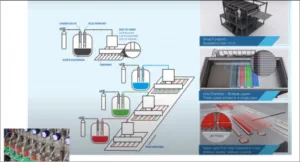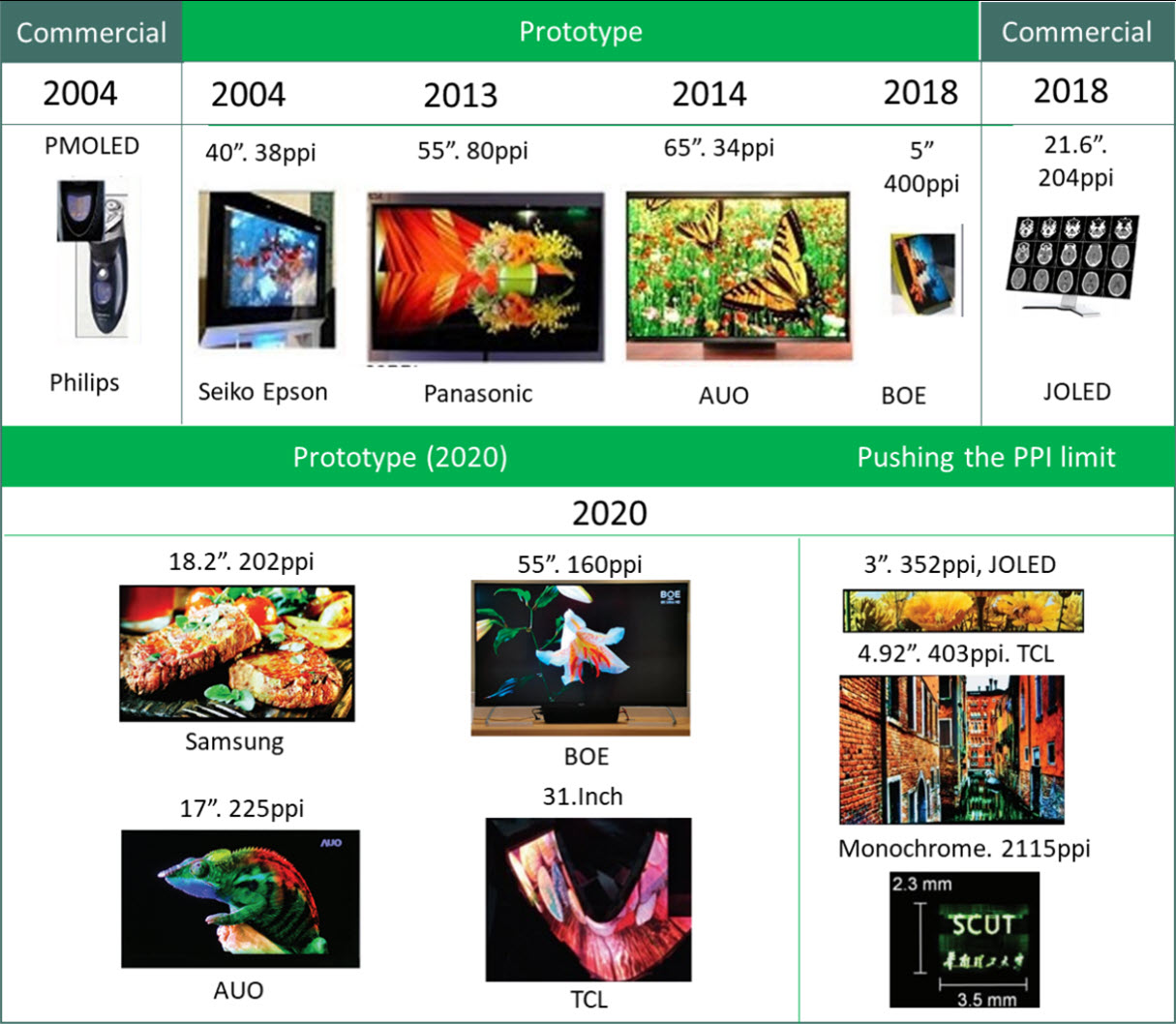In this article, I will show you how different types of printing are impacting, and will impact, various display technologies including AMOLED, AMQLED, microLEDs, AR/VR, electrochromic, and beyond.

(Many of the innovations and trends highlighted below will be part of TechBlick’s upcoming LIVE(online) conference and tradeshow on Innovations in Displays and Lighting taking place on 14-16 July.
At this conference, we bring together hand-picked speakers, each representing an important innovation trend in display material development, microLEDs, flexible and rollable displays, AR/VR, large-area lighting, printed displays, and beyond. You can see the full agenda here.)
AMOLED: from TFE to printed RGB emitters
Inkjet printing has already been commercialized in OLED displays. It is used in the deposition of the organic layer in multi-layer thin-film encapsulation. Here, inkjet printed organics act as buffer layers separating PECVD-deposited inorganic layers. This is shown below. This is already an established process.
 Example of inkjet printed and UV cured organic buffer layers in multi-layer thin film encapsulation. Image is from Kateeva 2017
Example of inkjet printed and UV cured organic buffer layers in multi-layer thin film encapsulation. Image is from Kateeva 2017
The printing of the emissive RGB layers is more challenging. The technology has been in development for at least 20 years. Indeed, solution-processed OLED materials have come a long way in their twenty years of developments. Today, both polymeric and small molecule solution-processed materials show performance levels that are almost on a par with evaporated emitters.
The three benchmarking charts- update as of Q1 2021- benchmark the performance levels for printed red, green, and blue vs evaporated versions. Here both small molecule and polymeric materials systems from the leading suppliers are included. We can see that the performance gaps are now largely bridged, especially for red and green, paving the way for adoption without too much performance penalty. The lifetime, especially blue, perhaps needs further refinement.
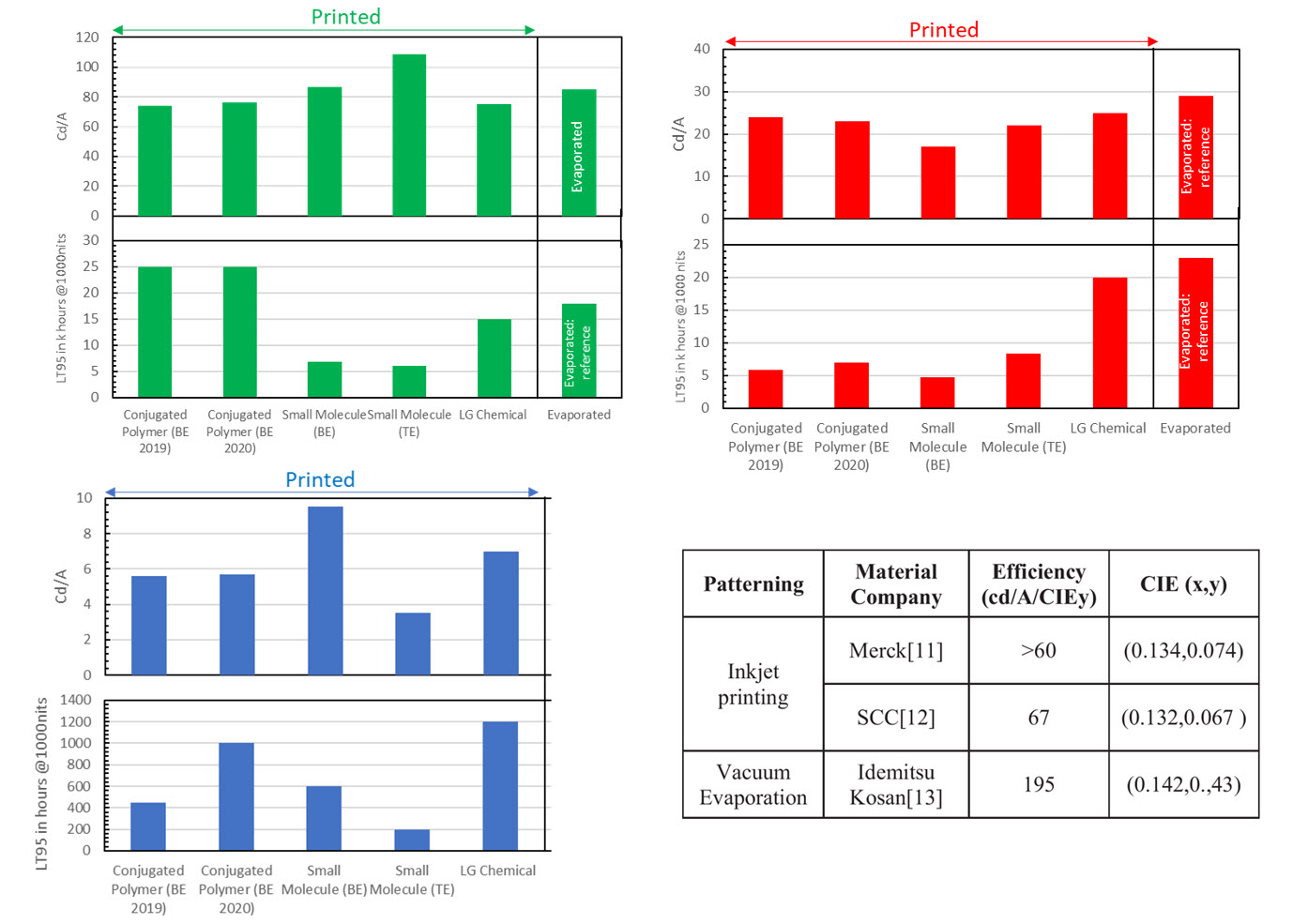 The charts compare printed OLED performance vs evaporated materials (as of Q1 2021). Note that for blue we did not include a reference evaporated material as it is difficult to compare because of different color coordinates. Instead, we included the bottom right chart. This chart is from 2020 (Samsung) and compares evaporated vs printed blue whilst factoring in color coordinates. Here, TE and BE denote top and bottom emission, respectively. To learn more see here
The charts compare printed OLED performance vs evaporated materials (as of Q1 2021). Note that for blue we did not include a reference evaporated material as it is difficult to compare because of different color coordinates. Instead, we included the bottom right chart. This chart is from 2020 (Samsung) and compares evaporated vs printed blue whilst factoring in color coordinates. Here, TE and BE denote top and bottom emission, respectively. To learn more see here
The printing machinery and process know-how have also come a long way. The image below simply showcases some examples of inkjet printed OLED displays. There are improvements both in size and PPI. These trends will continue. Indeed, some manufacturing has been in mass production mode for 21.6” inch displays since 2018. There will be more to come.
Note that additive deposition is not limited just to inkjet printing and solution processed materials. UDC (Universal Display Corp) has an interesting approach of vapor jetting evaporated OLED materials, thus achieving additive manufacture whilst exploiting the proved performance of evaporated materials.
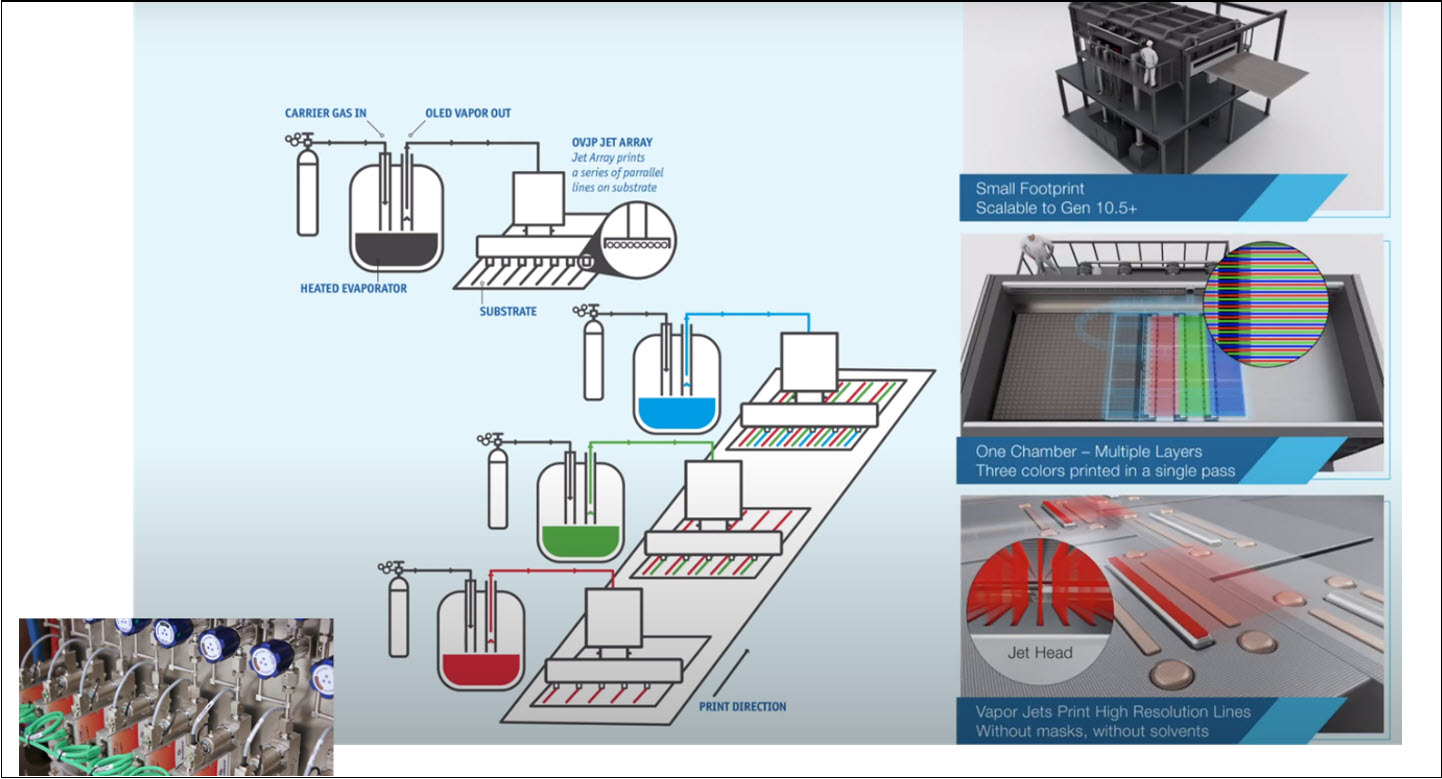 This is a fully evaporated additive side-by-side RGB deposition system with the performance of evaporated material and a route to Gen10 scale up. This is from UDC. To learn more see here
This is a fully evaporated additive side-by-side RGB deposition system with the performance of evaporated material and a route to Gen10 scale up. This is from UDC. To learn more see here
QLED: from enhancement film to OLED-QLED to AMQLED
Quantum Dots (QDs) are a major success story. As color converters, they deliver value to LCD, OLED, and microLED displays. They widen the color gamut of LCD, enabling them to remain performance competitive against OLEDs. They can be used on blue OLEDs to achieve WCG large-area partially printed displays with excellent contrast. In microLEDs, they enable achieving RGB using small-sized blue LEDs. In addition, there is the use of QLEDs in truly emissive QD-based displays.
The main application today remains LCD. Here, the current dominant mode of integration in displays remains the enhancement mode film. I mention this here in the printing context because here the QD-filled resins are R2R coated. An example is shown below.
 R2R slot die coated QD resin enhancement films for expanding the color gamut of LCDs. To learn more see here Image credit:Nanosys
R2R slot die coated QD resin enhancement films for expanding the color gamut of LCDs. To learn more see here Image credit:Nanosys
QDs can of course be used as color filters/color convertors both on LCDs and OLEDs. The integration with OLEDs is particularly interesting. One approach is to deposit a continuous blue layer stack (or multiple blue layer stacks to divide up the voltage and thus prolong lifetime). To get red and green, narrowband quantum dots (QDs) can then be inkjet printed on each pixel, acting as a color filter/color converter.
This approach is promising because it allows the achievement of fully emissive, printed, and large area displays with excellent color gamut and contrast. This approach is being actively pursued by Samsung (seeking to find a way to bring OLED and emissive display to larger areas) and multiple other firms. There is significant multi-billion dollar investment in this approach.
This approach is also interesting because it provides excellent ways to learn on the way towards the future fully printed AMQLED. Electrically-stimulated QLED materials are at a relatively early stage of development, but they promise to be the ultimate form of display: inkjet printed, large area, emissive, high EQE, high contract, thin, WCG, etc.
The technology development is of course not straightforward.
- The non-Cd containing QDs need to improve the EQE and lifetime,
- better blue compositions need to be formulated,
- the entire stack materials including transport layers need to be developed and optimized,
- suitable device architecture developed, and finally
- an active-matrix mass production process that goes beyond spin coating needs to be developed.
There is rapid progress here and it is not my purpose to detail all the developments. Just to show the complexity level, I showcase the example below from BOE, which is a 55-inch fully inkjet printed AMQLED (May 2021).
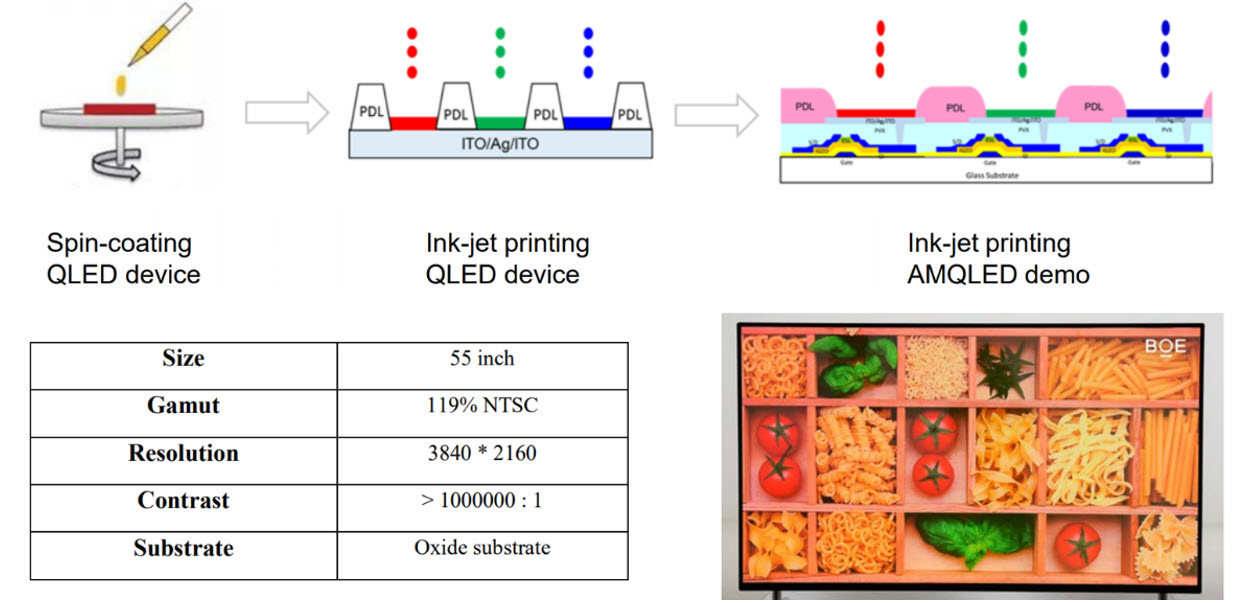 This is an IJP 55-inch AMQLED by BOE. The EQE and other performance data were reported only for spin coated QLED device and not IJP AMQLED. To learn more see here
This is an IJP 55-inch AMQLED by BOE. The EQE and other performance data were reported only for spin coated QLED device and not IJP AMQLED. To learn more see here
Precision and repair
Digital printing is evolving well beyond just inkjet. Indeed, emerging approaches enhance the printing resolution to the sub-micron range and/or enable deposition on non-flat surfaces. These electrohydrodynamic (single or multi-head), aerosol, and/or micro-dispensing technologies can have many potential applications in the display industry.
The example below shows how micro-dispensing can be deployed to repair open defects on a complex non-flat AMOLED surface. Another example below shows how this process, or version with multiple EHD print heads, can deposit the attach materials for placement of ever smaller microLEDs.
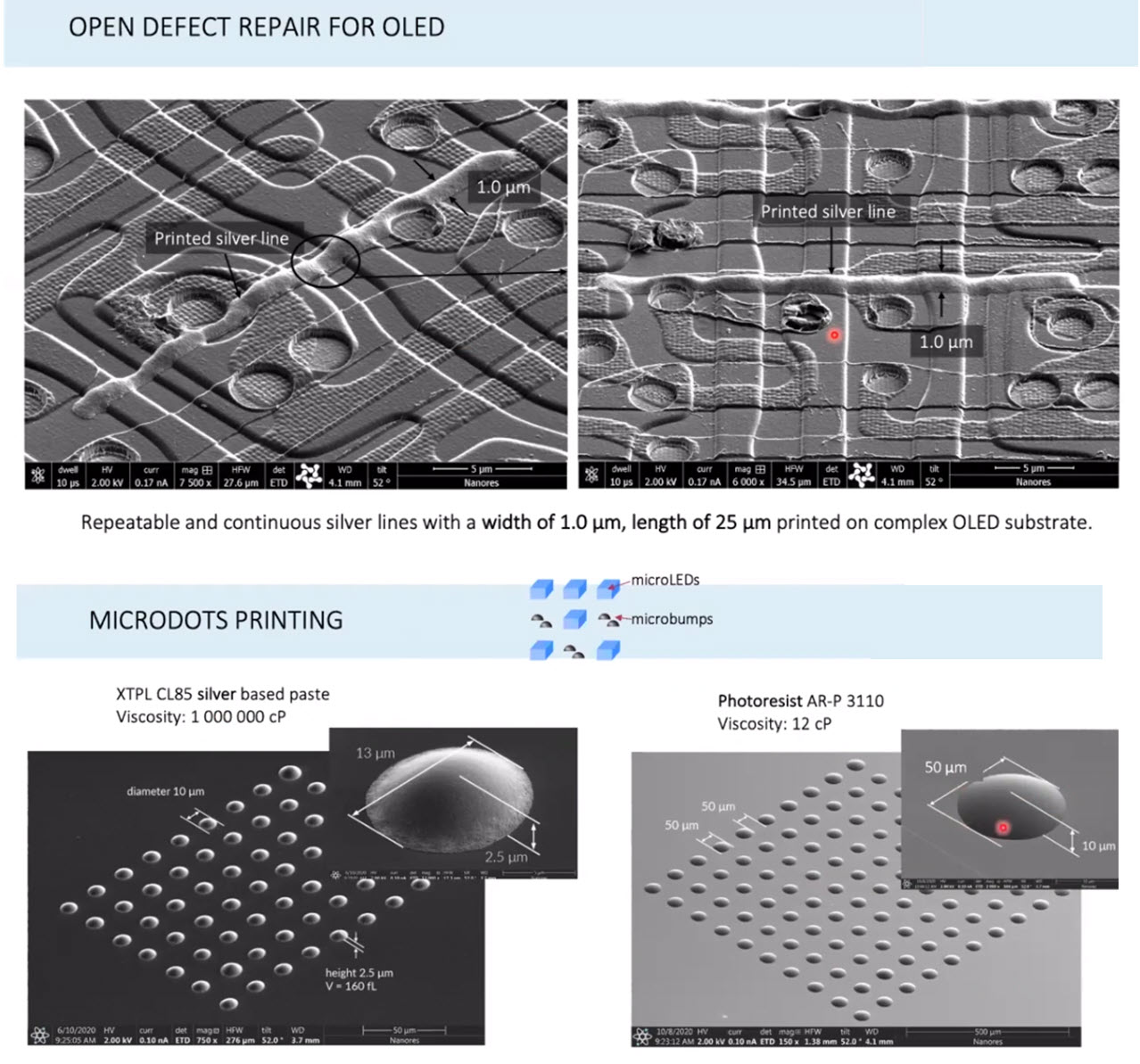 Two examples of how precision digital printing can be used in OLED and microLED display. These examples are from XTPL using their microdispensing machine and their highly viscous silver nanoinks. To learn more see here
Two examples of how precision digital printing can be used in OLED and microLED display. These examples are from XTPL using their microdispensing machine and their highly viscous silver nanoinks. To learn more see here
This is the first part of a two-part article. Tomorrow we’ll look at microLEDs and other applications.(KG)
Dr Khasha Ghaffarzadeh is CEO and Founder at TechBlick
Note that for Display Daily readers, the second part will not count towards your monthly free article count.

